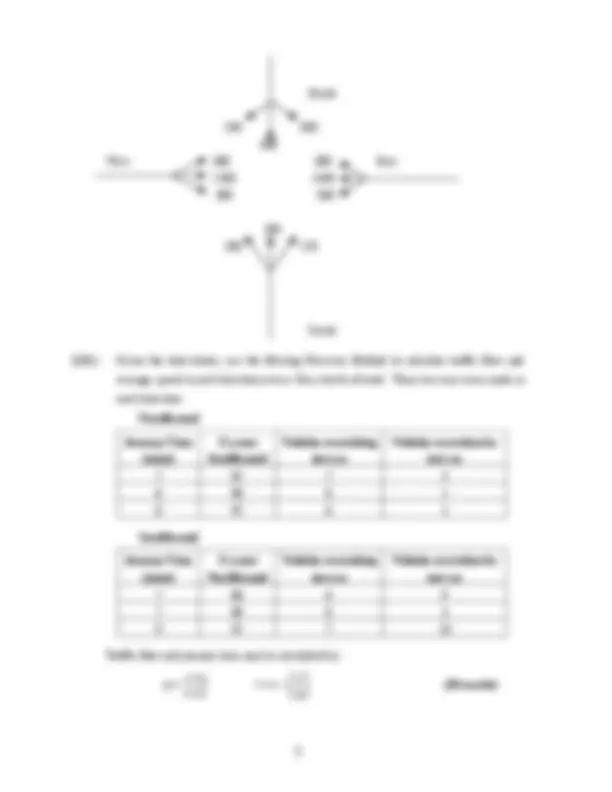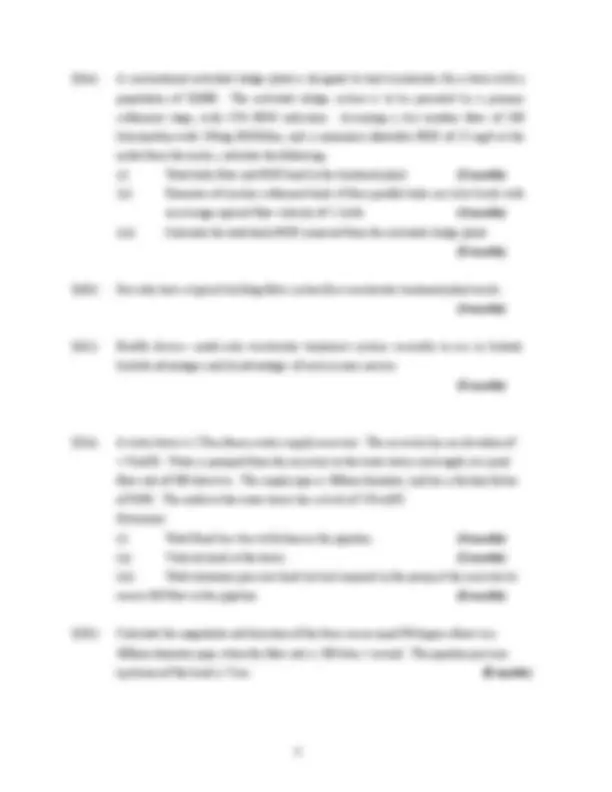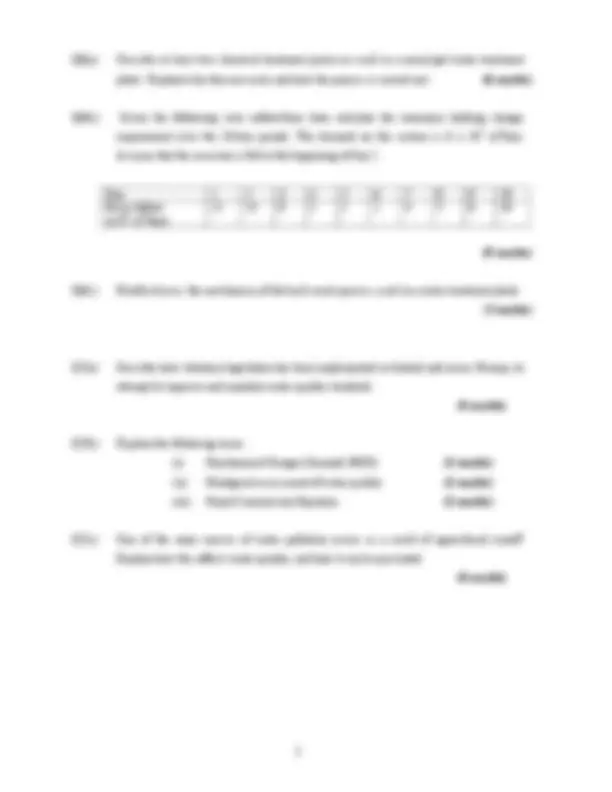





Study with the several resources on Docsity

Earn points by helping other students or get them with a premium plan


Prepare for your exams
Study with the several resources on Docsity

Earn points to download
Earn points by helping other students or get them with a premium plan
Community
Ask the community for help and clear up your study doubts
Discover the best universities in your country according to Docsity users
Free resources
Download our free guides on studying techniques, anxiety management strategies, and thesis advice from Docsity tutors
Main points of this past exam are: Hydrology of Area, Paths and Tarmac Entrance, Dillon Equation, Rational Equation, Minute Storm Duration, Tipping-Bucket Raingauge, Parshall Flume, Hydrographs, Polluter Pays Principle
Typology: Exams
1 / 5

This page cannot be seen from the preview
Don't miss anything!




Instructions Answer 5 questions All questions carry equal marks.
Examiners: Mr. L O’Driscoll Mr. P. Anthony Mr. J. Murphy
Q1(a) A large-scale shopping centre and car park is proposed for an area that was previously open parkland. How will this affect the hydrology of the area? Include in your answer a description of the direct affect on local stream and storm sewer flows. (4 marks)
Q1(b) A residential development consists of 105 sites. Each site includes a house with plan area 65m^2 , grass area 150m^2 , and paths and tarmac entrance 65m^2. The total road area servicing the development is 6,000m^2. Calculate the required storm sewer capacity at the outlet from the site (in litres/sec) for a 10 year return period storm, with a 15 minute storm duration. The storm sewer collects runoff from all of the impermeable surfaces of the site. (Assume 100% runoff from impermeable areas). (8 marks)
Dillon Equation (^35) p^15 t
Rational Equation Q(l/s) = 2.78 A(ha) I(mm/hr)
Q1(c) Explain the following terms: i. Tipping-bucket raingauge ii. Parshall Flume iii. Evapotranspiration iv. Hydrographs (8 marks)
Q2(a) Explain the following terms in relation to solid waste management: (i) Polluter pays principle (ii) WEE Directive (iii) Vermicomposting (6 marks)
Q2(b) A local authority produces 75,000 tonnes of waste per year. Design an individual landfill cell to accept this waste in a single year. Use sketches to show your design. Include a typical section through the landfill to show the base and capping details. (4 marks)
Q2(c) Discuss how construction and demolition (C&D) waste can be reduced at source by construction firms. Give examples of different types of C&D waste. Show how each of these could be reduced. Refer to the waste management hierarchy for each of these examples. (5 marks)
Q2(d) Describe the standard landfill selection process used to locate municipal landfill sites in Ireland. (5 marks)
Q3(a) The following traffic flows in pcu/hour were determined at a roundabout, based on traffic flow surveys. Is the roundabout capacity adequate (based on your analysis) given:
11m wide weaving sections, 42 m long in each quadrant, e 1 = 5m, e 2 = 10m
w
w w e Q
, e = e^1 + 2 e^2
(10 marks)
Q4(a) A conventional activated sludge plant is designed to treat wastewater for a town with a population of 50,000. The activated sludge system is to be preceded by a primary settlement stage, with 25% BOD reduction. Assuming a dry weather flow of 180 litres/pe/day with 250mg BOD/litre, and a maximum allowable BOD of 25 mg/l at the outlet from the works, calculate the following: (i) Total daily flow and BOD load to the treatment plant (2 marks) (ii) Diameter of circular settlement tanks if four parallel tanks are to be built, with an average upward flow velocity of 1.5m/hr (4 marks) (iii) Calculate the total daily BOD removed from the activated sludge plant. (5 marks)
Q4(b) Describe how a typical trickling filter system for a wastewater treatment plant works. (4 marks)
Q4(c) Briefly discuss small-scale wastewater treatment systems currently in use in Ireland. Include advantages and disadvantages of each in your answer. (5 marks)
Q5(a) A water tower is 27km from a water supply reservoir. The reservoir has an elevation of +75mOD. Water is pumped from the reservoir to the water tower each night, at a peak flow rate of 500 litres/sec. The supply pipe is 500mm diameter, and has a friction factor of 0.001. The outlet at the water tower has a level of 150 mOD. Determine: (i) Total Head loss due to friction in the pipeline. (^) (4 marks) (ii) Velocity head at the tower. (2 marks) (iii) Total minimum pressure head (in bar) required in the pump at the reservoir to ensure full flow in the pipeline. (6 marks)
Q5(b) Calculate the magnitude and direction of the force on an equal 90 degree elbow in a 300mm diameter pipe, when the flow rate is 100 litres / second. The pipeline pressure upstream of the bend is 5 bar. (8 marks)
Q6(a) Describe at least two chemical treatment processes used in a municipal water treatment plant. Explain why they are used, and how the process is carried out. (6 marks)
Q6(b) Given the following river inflow/time data calculate the minimum holding storage requirement over the 10-day period. The demand on the system is 6 x 10^5 m^3 /day. Assume that the reservoir is full at the beginning of day 1.
Day 1 2 3 4 5 6 7 8 9 10 River Inflow (x10^5 m^3 /day)
(9 marks)
Q6(c) Briefly discuss the mechanism of the back-wash process, used in a water treatment plant. ( 5 marks)
Q7(a) Describe how statutory legislation has been implemented in Ireland and across Europe, to attempt to improve and maintain water quality standards. (5 marks)
Q7(b) Explain the following terms: (i) Biochemical Oxygen Demand (BOD) (3 marks) (ii) Biological assessment of water quality (3 marks) (iii) Royal Commission Equation (3 marks)
Q7(c) One of the main sources of water pollution occurs as a result of agricultural runoff. Explain how this affects water quality, and how it can be prevented. (6 marks)